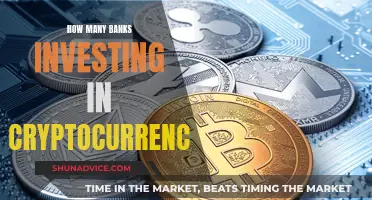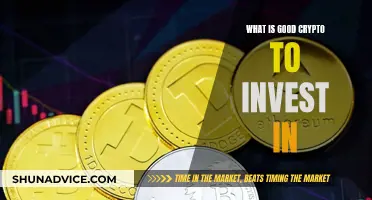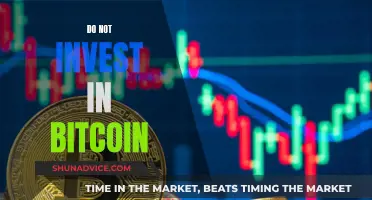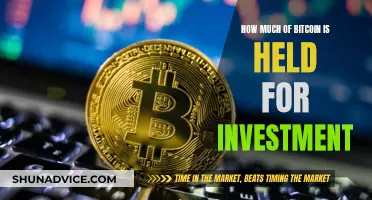
Dogecoin is a cryptocurrency that was started as a joke in 2013. Its name comes from a Shiba Inu dog meme from 2012/2013. Despite its lighthearted origins, Dogecoin has become one of the most highly valued cryptocurrencies, thanks in part to endorsements from celebrities such as Elon Musk. In this article, we will discuss how to invest in Dogecoin, including the risks involved and the steps to take.
| Characteristics | Values |
|---|---|
| Type | Cryptocurrency |
| Started | 2013 |
| Founders | Billy Markus and Jackson Palmer |
| Based on | Doge meme, a Shiba Inu dog |
| Supply | Unlimited |
| Current Price | $0.10-$0.45 |
| Market Cap | $10,383,370,714 |
| High Price | $0.55 in May 2021 |
| Where to Buy | eToro, Robinhood, Coinbase, Uphold, Webull, Kraken, Crypto.com, Binance.US |
What You'll Learn

Dogecoin's risks and volatility
Dogecoin is a highly volatile cryptocurrency. Its price can fluctuate dramatically within a short period, leading to potential losses. This volatility is due to several factors, including social media hype, market manipulation by large holders or 'whales', correlation with Bitcoin, and low market capitalisation.
Volatility Challenges
Dogecoin has a history of sudden and dramatic price swings, which can catch traders off guard and lead to substantial losses. The cryptocurrency is susceptible to manipulation by large holders or 'whales', who can influence the price by buying or selling large amounts. Dogecoin's price movements are also closely tied to Bitcoin's performance, so traders need to be mindful of Bitcoin's price shifts.
Social Media Hype
The influence of social media on the Dogecoin cryptocurrency market cannot be underestimated. The rapid dissemination of information and opinions through platforms like Twitter, Reddit, and TikTok can lead to exaggerated price movements driven by hype and speculation. While social media can provide valuable insights and real-time updates, traders must exercise caution when making decisions based solely on social media trends.
Security Concerns
Dogecoin transactions are conducted through digital wallets, which are susceptible to hacking and theft. Traders must ensure they use reputable wallets and take the necessary steps to secure their private keys. Additionally, scams and fraudulent activities are prevalent in the cryptocurrency trading space. It is essential to be cautious of Ponzi schemes, fake investment opportunities, and phishing attempts that aim to steal your Dogecoin or personal information.
Regulatory and Legal Considerations
Different countries have varying regulatory perspectives on cryptocurrencies like Dogecoin, which can impact trading activities. For example, China has banned initial coin offerings (ICOs) and restricted cryptocurrency trading activities, while countries like Malta and Switzerland have implemented progressive regulations to attract crypto businesses. Traders and investors must also consider the tax implications of their Dogecoin transactions, as these can vary depending on the jurisdiction.
Mitigating Risks
To mitigate risks while trading Dogecoin, it is crucial to employ strategies for managing volatility. This includes closely monitoring market trends and setting clear entry and exit points for trades. Additionally, maintaining security in Dogecoin trading requires implementing best practices such as using secure wallets, enabling two-factor authentication, and regularly updating software. Diversification is also key to reducing risks, as it helps spread investments across different assets and minimises the impact of any single asset's performance. Lastly, understanding Dogecoin's liquidity is essential for making informed trading decisions.
Bitcoin Investment: Is This the Week to Buy?
You may want to see also

Choosing a crypto exchange
Crypto exchanges are platforms that allow users to buy and sell cryptocurrencies. They are the gateway to the cryptocurrency market, and there are hundreds of them available to traders and investors. When choosing a crypto exchange, there are several important factors to consider.
Firstly, it is crucial to ensure the authenticity and security of the platform. Crypto exchanges are prime targets for hackers, so it is essential to select an exchange with robust security measures. It is also important to research the reputation of the platform and check the various security protocols they have in place to protect your data and funds.
Secondly, consider the method of purchasing cryptocurrencies. Different platforms support different payment options, such as bank transfers, PayPal, credit and debit cards, or cryptocurrency. Choose a platform that accepts fiat currency if you are just starting and do not yet own any cryptocurrencies.
Thirdly, look into the supported coins and tokens offered by the exchange. While most exchanges support Bitcoin and Ethereum, there are thousands of other cryptocurrencies, and some investors may want exposure to a wider range of options. Binance, for example, grants traders access to a vast array of cryptocurrencies.
Another key factor is the transaction fee structure. It is important to understand the fees associated with different activities on the platform, such as trading and withdrawals. Choose an exchange with transparent and competitive fees, and be wary of hidden transaction costs.
Finally, consider the user interface and user experience. An intuitive and user-friendly platform can make trading cryptocurrencies much easier. Additionally, look into the customer service and other customer-related functionalities offered by the exchange.
Some of the most popular and powerful crypto exchanges include Binance, Coinbase, Kraken, and CEX.io. These exchanges offer a wide range of cryptocurrencies, robust security measures, and user-friendly platforms, making them a good choice for both beginners and experienced traders.
Why Ripple Could Be a Better Investment Than Bitcoin
You may want to see also

Payment methods for buying Dogecoin
Once you've chosen a crypto exchange and set up your account, you will need to deposit money into your account. You will then have access to three main payment methods for buying Dogecoin (or any other cryptocurrency).
Credit Card
This is the fastest method for buying crypto but it is also the most expensive. Fees can range from just under 2% up to 3%, plus a flat fee.
Bank Transfer
This is the slowest method and can take 2-3 days to complete. Most exchanges offer direct access to the exchange.
Cryptocurrency
With this option, you trade a cryptocurrency that you own with another crypto trader who owns DOGE. Fees are typically lower when you go this route, often coming in at less than 1%. However, direct trading can be more complex and may be intimidating for beginners.
The Ultimate Guide to Investing in Bitcoin Stock
You may want to see also

Moving Dogecoin from the exchange to your wallet
Once you've purchased Dogecoin, you'll need to move it from the exchange to your wallet. This will ensure that your crypto is secure and give you full control over it.
Firstly, if you don't already have a crypto wallet, you'll need to get one. Crypto wallets typically integrate into browsers or mobile apps and come with a password, which you'll need to keep safe. Hardware wallets are also an option, but they tend to cost between $70 and $100, so you probably won't need one unless you're buying large amounts of crypto.
Next, simply supply your wallet address to get your coins out of the exchange. You can do this by locating and copying the relevant files and using your computer's copy operation to place them into your chosen destination. Make sure you verify that they are OK by using your wallet's file open operation to access them.
Finally, close the original wallet to avoid confusion. This won't delete the wallet or its contents.
Bitcoin for Everyone? Exploring Average Joe's Investment
You may want to see also

Dogecoin's future prospects
However, Dogecoin has a strong community and has been around for a long time, giving it a place in the crypto space. It also has low fees and fast transaction speeds, making it a popular choice for moving money between cryptocurrency exchanges. The influence of celebrities and social media continues to impact its price, and it has been fuelled by endorsements from figures such as Elon Musk, Snoop Dogg, and Mark Cuban.
The crypto market is largely interconnected, and Dogecoin's price often moves in tandem with Bitcoin and other major cryptocurrencies. When Bitcoin reached an all-time high in 2024, Dogecoin's price also surged by ~100%.
Dogecoin's future will depend on its ability to maintain relevance and broaden its utility beyond being a meme coin. Technical upgrades, merchant adoption, community growth, and protocol upgrades could enhance its viability. While Dogecoin reaching $1 is possible, it is not guaranteed and depends on addressing scaling challenges and gaining mainstream utility.
In summary, Dogecoin's future prospects are speculative, and it remains a highly volatile and risky investment. Its price is heavily influenced by social media and celebrity endorsements, and its value could surge or crash at any time. While Dogecoin has some positive attributes, it lacks the finite supply and practical applications of other major cryptocurrencies, which could hinder its long-term prospects.
The Optimal Bitcoin Investment Strategy: How Much to Invest?
You may want to see also
Frequently asked questions
You can buy Dogecoin by opening an account with a crypto exchange such as eToro, Robinhood, Coinbase, Webull, Kraken, Crypto.com, or Binance.US. You will need to verify your identity, which usually takes a few days. Once your account is verified, you will need to fund your account through wire transfer, ACH transfer, or credit/debit card. Then, you can place a buy order at a suitable price.
Dogecoin is extremely volatile and is considered a risky investment. It is also not as widely accepted as other cryptocurrencies, such as Bitcoin. However, it has gained mainstream attention and has a strong community supporting it. Dogecoin is a good option for crypto novices as it can give them a glimpse of what crypto investing is all about.
Dogecoin is a cryptocurrency that was started as a joke in 2013 by software engineers Billy Markus and Jackson Palmer. It is based on the Doge meme, a Shiba Inu dog that speaks in broken English. Dogecoin was created to poke fun at Bitcoin and the idea of buying a digital asset that is not backed by any asset or cash flow.







